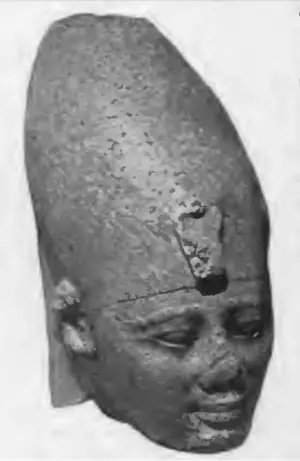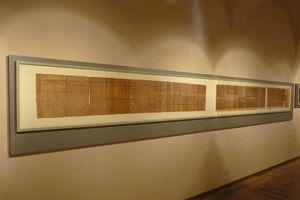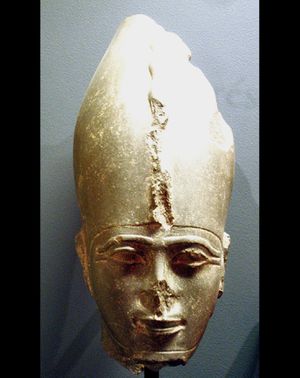Difference between revisions of "Was Regicide Common in Ancient Egypt"
(Created page with "300px|thumbnail|left|Statue of King Amenemehat I (ruled ca. 1991-1962 BC) Regicide, the murder or assassination of a king or other royal is one of th...") |
|||
| Line 31: | Line 31: | ||
Psamtek III’s regicide brought an end to the Twenty-Sixth Dynasty and ushered in a period of instability and decline that would last until Alexander the Great arrived in Egypt in 332 BC. Before Alexander and the Macedonians came to Egypt, the Nile Valley would witness at least one more case of regicide. The primary source documentation of post-Saite Egypt is often sketchy at best because the dynasties were often too unstable to erect any monuments and Herodotus’ accounts of course ended with his death. Other Greek historians and geographers such as Diodorus and Strabo are helpful, but their accounts take the Greek perspective so important details concerning the Egyptian kings were often overlooked. In the midst of this chaotic period in Egypt, the particularly weak Twenty-Ninth Dynasty was apparently overthrown by an able king named Nectanebo I (ruled 379-361 BC), who became the first king of the Thirtieth Dynasty. Nectanebo I’s usurpation of the throne was commemorated on the hieroglyphic text known as the “Hermopolis Stela,” which indicates that he may have also killed the last king of the previous dynasty. | Psamtek III’s regicide brought an end to the Twenty-Sixth Dynasty and ushered in a period of instability and decline that would last until Alexander the Great arrived in Egypt in 332 BC. Before Alexander and the Macedonians came to Egypt, the Nile Valley would witness at least one more case of regicide. The primary source documentation of post-Saite Egypt is often sketchy at best because the dynasties were often too unstable to erect any monuments and Herodotus’ accounts of course ended with his death. Other Greek historians and geographers such as Diodorus and Strabo are helpful, but their accounts take the Greek perspective so important details concerning the Egyptian kings were often overlooked. In the midst of this chaotic period in Egypt, the particularly weak Twenty-Ninth Dynasty was apparently overthrown by an able king named Nectanebo I (ruled 379-361 BC), who became the first king of the Thirtieth Dynasty. Nectanebo I’s usurpation of the throne was commemorated on the hieroglyphic text known as the “Hermopolis Stela,” which indicates that he may have also killed the last king of the previous dynasty. | ||
| − | “His majesty came to Hesiret for him, in the time of the king, he was a general. The one, he became ruler . . . the hill country in the land of the mayor. He delivered the rebel to the work (monument) of the town officials and he caused to make the children live in the rage of the king who were before him. Son of Ra, lord, Nectanebo I, who lives like Ra.” Roeder, Gunther. “Zwei hieroglyphische Inschriften aus Hermpolis (Ober-Ägypten).” <i>Annales du Service des antique’s de l’Égypte.</i> 52 (1952) p. 389</ref> | + | “His majesty came to Hesiret for him, in the time of the king, he was a general. The one, he became ruler . . . the hill country in the land of the mayor. He delivered the rebel to the work (monument) of the town officials and he caused to make the children live in the rage of the king who were before him. Son of Ra, lord, Nectanebo I, who lives like Ra.” <ref> Roeder, Gunther. “Zwei hieroglyphische Inschriften aus Hermpolis (Ober-Ägypten).” <i>Annales du Service des antique’s de l’Égypte.</i> 52 (1952) p. 389</ref> |
Since the king killed would have been considered a rebel and anathema to the Egyptians, his name was never mentioned but it was obviously Nefertites II (reigned 379-380 BC), the last king of the Twenty-Ninth Dynasty. | Since the king killed would have been considered a rebel and anathema to the Egyptians, his name was never mentioned but it was obviously Nefertites II (reigned 379-380 BC), the last king of the Twenty-Ninth Dynasty. | ||
Revision as of 22:07, 3 September 2018
Regicide, the murder or assassination of a king or other royal is one of the final taboos in human history. There are several notable examples of regicide throughout human history, which have made for good historical fiction and drama in modern times. The reality is that regicide is more the exception than the rule, although when it happens it tends to happen in places and times that are marked by social and political instability, which may make it seem more common than it truly is.
Modern depictions of ancient Egypt, especially fictional representations, tend to depict political murder as a common political expedient. Enemies of the king, or sometimes the king himself, are routinely murdered, sometimes by being mummified alive, in these films. The reality is quite the opposite. Political murder in general and regicide in particular was quite rare for much of ancient Egypt’s history, but during the time known as the Late Period (ca. 728 - 332 BC) regicide became quite common in the Nile Valley. As Egypt was invaded and ruled by wave after wave of foreign dynasties, regicide became a common tool by which the new sovereign would not only eliminate his predecessor, but also all vestiges of the previous dynasty.
Contents
Regicide in the Old, Middle, and New Kingdoms
During the approximately 2,000 year period from the inception of the Egyptian in 3100 BC ca. to the end of the New Kingdom in 1075 BC, there are only three possible documented occurrences of regicide. The reason for this has been debated among Egyptologists for decades, but it more than likely stems from the fact that the Egyptians had a deep belief in the divinity of their rulers. To the Egyptians, their kings were literally gods, which they first articulated in writing in the so-called Pyramid Texts of the Fifth and Sixth dynasties (ca. 2465-2300 BC). The texts, which were written on the walls and ceilings of the kings’ burial chambers within the pyramids, were meant to assert the king’s divinity and his connection to the gods Osiris, Re, and Atum among others. [1] The ancient Egyptians’ strong belief in the divinity of their kings may have mitigated the occurrences of regicide, but it did not stop the act from happening totally, as one king was killed in each of Egypt’s three kingdoms.
The first Egyptian king to die at the hands of assassins was Teti (ruled ca. 2345-2333 BC), or “Othoes” in Greek. According to the third century BC Hellenized Egyptian historian, Manetho, Teti “was murdered by his bodyguard.” [2] Less than 500 years later, another Egyptian king was struck down by his attendants. The second attested case of regicide in ancient Egypt was committed against Amenemhat I (reigned ca. 1985-1955 BC), who was the first king of the Thirteenth Dynasty in the Middle Kingdom. Manetho’s account states, “Ammanemês, for 38 years: he was murdered by his own eunuchs.” [3] Unlike Teti’s assassination, though, there is another primary sources that corroborates Manetho’s account. The corroborating text is the so-called “Papyrus Millingen,” which is a papyrus written in the hieroglyphic script dated to the Middle Kingdom, so it is more contemporary than Manetho’s account. Much like Manetho’s account, the papyrus describes the assassination as the result of a palace conspiracy. [4]
The final Egyptian king who may have been assassinated before the Late Period was the second king of the Twentieth Dynasty, Ramesses III (ruled 1184-1153 BC). Ramesses III is best known for successfully fending off assaults from the Libyans and Sea Peoples, but according to the “Judicial Papyrus of Turin,” he may have been the victim of regicide. The content of the papyrus is primarily a combination religious-historical text, but there is also a section that details court proceedings brought against court conspirators who apparently assassinated the king. [5] There is no Manetho account that corroborates the papyrus.
Regicide in the Late Period
The relative political stability that Egypt enjoyed for its first 2,000 plus years of history was replaced by a period of turmoil and dynastic conflict that began when the Nubians conquered Egypt in 728 BC. Just prior to the initial Nubian invasion, a Libyan descended dynasty came to power in the Delta city of Sais, who were not too keen to hold over their somewhat circumscribed power base to the Nubians. For their part, the Nubians were not fine with letting the rulers of Sais maintain any degree of autonomy, so the second king of the Nubian Twenty-Fifth Dynasty, Shabaqa (ruled 712-702 BC), invaded the Delta shortly after coming to power and killed the sole king of the Sais based Twenty-Fourth Dynasty, Bakenrenef (reigned 717-712 BC). According to Manetho, Shabaqa burned Bakenrenef alive, which would seem counter to Egyptian tradition because the body was needed to be intact in order to effectively transition into the afterlife. [6] But as modern scholars have pointed out, Shabaqa was a Nubian and although Bakenrenef was from Egypt, his ancestry was Libyan, so the probability is that the rulers viewed each other as foreign and non-Egyptian. Also, fire would have been a perfectly acceptable means to kill a transgressor for treason in ancient Egypt. [7]
After killing Bakenrenef, the Nubians held power over all Egypt, but their rule was tenuous at best. The people of Sais, who have come to be known as “Saites,” continued to pose problems and even worse was the specter of the Assyrians to the east. Nekau I, the ruler of Sais and progenitor of the Twenty-Sixth Dynasty, took advantage of the situation by pledging fealty to Assyrian King Ashurbanipal (ruled 668-627 BC). The situation came to a head when the Nubian King Tantamani marched north to challenge the Saite king, apparently killing him in battle.
The regicide of Nekau I is mentioned in two primary sources. The fifth century BC Greek historian, Herodotus, mentions the assassination in a somewhat anachronistic account. Herodotus wrote that Psamtek I, “Psammeticus” in Greek, who was actually Nekau I’s son and heir, “fled the country to escape Sabacos, the Ethiopian, who had killed Necos his father.” [8] The account is accurate in that Nekau I was probably killed in some type of battle with the Nubians, but the Nubian king in question was Tantamani, not Shabaqa/Sabacos. Also, Psamtek never fled Egypt and in fact was responsible for expelling the Assyrians and unifying the country once more in 664 BC. The anachronistic Herodotus account is corroborated to a certain degree by a hieroglyphic text known as the “Dream Stela.” The stela recounts the battles between Nekau I and Tantamani from the latter’s perspective. The “chiefs of the North” is a reference to the Saites’ Libyan descent:
“Now, after these things, his majesty sailed north, to fight with the chiefs of the North. Then they entered their strongholds [as beasts crawl into] their holes. Then his majesty spent many days before them, (but) there came not forth one of them to fight with his majesty. Then his majesty sailed southward to Memphis.” [9]
Once Psamtek I assumed the kingship over Egypt, the Nubians retreated to their homeland and never again played a major role in ancient Egyptian politics. The first few decades of the Twenty-Sixth Dynasty were marked by political stability and a cultural renaissance, but by the rule of the fifth king of the dynasty, Apries (reigned 589-571 BC), the political situation had quickly deteriorated. Apries was overthrown by one of his generals, Ahmose II (ruled 571-526 BC), who according to Herodotus “strangled him, and buried his body in the family tomb.” [10] Ahmose II brought stability back to Egypt for a short period, but his successor was unable to contend with more powerful forces from the east.
As the Saites and Nubians routinely assassinated each other during the Late Period, the Achaemenid Persians were quickly toppling the long-enduring kingdoms of the Near East. After the Cambyses of Persian conquered Babylon in 539 BC, he turned his eyes to Egypt, which was led at the time by Psamtek III (reigned 526-525 BC). Psamtek III was not a very able ruler and after Egypt was overwhelmed by Persian military forces, Cambyses allowed him to keep his title nominally as long as he never challenged the Persian king. According to Herodotus, though, Psamtek III was not content to be a figure head.
“He was caught trying to raise a revolt amongst the Egyptians, and as soon as his guilt was known by Cambyses, he drank bull’s blood and died on the spot.” [11]
Psamtek III’s regicide brought an end to the Twenty-Sixth Dynasty and ushered in a period of instability and decline that would last until Alexander the Great arrived in Egypt in 332 BC. Before Alexander and the Macedonians came to Egypt, the Nile Valley would witness at least one more case of regicide. The primary source documentation of post-Saite Egypt is often sketchy at best because the dynasties were often too unstable to erect any monuments and Herodotus’ accounts of course ended with his death. Other Greek historians and geographers such as Diodorus and Strabo are helpful, but their accounts take the Greek perspective so important details concerning the Egyptian kings were often overlooked. In the midst of this chaotic period in Egypt, the particularly weak Twenty-Ninth Dynasty was apparently overthrown by an able king named Nectanebo I (ruled 379-361 BC), who became the first king of the Thirtieth Dynasty. Nectanebo I’s usurpation of the throne was commemorated on the hieroglyphic text known as the “Hermopolis Stela,” which indicates that he may have also killed the last king of the previous dynasty.
“His majesty came to Hesiret for him, in the time of the king, he was a general. The one, he became ruler . . . the hill country in the land of the mayor. He delivered the rebel to the work (monument) of the town officials and he caused to make the children live in the rage of the king who were before him. Son of Ra, lord, Nectanebo I, who lives like Ra.” [12]
Since the king killed would have been considered a rebel and anathema to the Egyptians, his name was never mentioned but it was obviously Nefertites II (reigned 379-380 BC), the last king of the Twenty-Ninth Dynasty.
Conclusion
Regicide was an extremely rare act for most of ancient Egyptian history. During the first 2,000 years of Egypt’s history as a state there are only three known incidents of a king being murdered, but in the period from 712 to 379 BC there were at least four regicides. The primary reason for this change was that the dynasties of the Late Period were often foreign, or foreign descended, and therefore were built upon unstable political bases. These dynasties also had a lack of connection with Egypt’s past and probably did not view the king as truly divine the way earlier Egyptians did.
References
- ↑ Kemp, Barry J. “Old Kingdom, Middle Kingdom, and Second Intermediate Period.” In Ancient Egypt: A Social History. Edited by Bruce G. Trigger, Barry J. Kemp, David O’Connor, and Alan B. Lloyd. (Cambridge, United Kingdom: Cambridge University Press, 2004), pgs. 72
- ↑ Manetho. Aegyptiaca. Translated by W.G. Waddell. (Cambridge, Massachusetts: Harvard University Press, 2004), Fragments 19a, b; 20
- ↑ Manetho, Fragments 34-36
- ↑ Lichtheim, Miriam. Ancient Egyptian Literature: A Book of Readings. Volume 1, The Old and Middle Kingdoms (Los Angeles: University of California Press, 2006), p. 137
- ↑ Kuhrt, Amélie. The Ancient Near East: c. 3000-330 BC. (London: Routledge, 2010), p. 187
- ↑ Manetho, Fragments 66-67
- ↑ Leahy, Anthony. “Death by Fire in Ancient Egypt.” Journal of the Economic and Social History of the Orient. 22 (1984) p. 200
- ↑ Herodotus. The Histories. Translated by Aubrey de Sélincourt. (London: Penguin, 2003), Book II, 15
- ↑ Breasted, Henry, ed. and trans. Ancient Records of Egypt. Volume 4, The Twentieth through Twenty-sixth Dynasties (Chicago: University of Illinois Press, 2001), p. 471
- ↑ Herodotus, Book II, 169
- ↑ Herodotus, Book III, 15
- ↑ Roeder, Gunther. “Zwei hieroglyphische Inschriften aus Hermpolis (Ober-Ägypten).” Annales du Service des antique’s de l’Égypte. 52 (1952) p. 389



